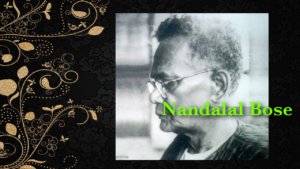Nandalal Bose is the brightest name in the field of art. The present article is on the biography of this great man and also his works as an artist.

Contents [Nandalal Bose Biography Works as an Artist]
- Birth and Death
- Parents
- Influence of parents
- Early Life
- Art Works
- Estimate as an author and Artist
- Awards
Birth and Death
- Nandalal Bose was a notable Indian painter of Bengal school of art. He was born on 3rd December, 1882 in a small town of Haveli Kharagpur in Bihar.
- Nandalal Bose breathed his last at the age of eighty two on 16th April, 1966.
Parents
His father Purnachandra Bose was the manager of Kharagpur Estate of the Raja of Darbhanga while his mother Kshetramani was an orthodox woman of religious piety.
Influence of his parents
He inherited some of the painting virtues from his parents. He acquired the discipline and a hard-working nature from his father but his mother’s interests for drawing and craftsmanship helped him much in building a career in painting.
Early life
- During his early years, he had a great fascination for coloured pictures and he searched for them in old books and magazines.
- In the classroom he engaged himself in making sketches rather than taking down notes.
- At the age of fifteen, he moved to Calcutta to pursue higher studies. He was admitted to Central Collegiate School from where he completed his school education.
- After marriage, he was advised by his father-in-law to join Presidency College to study Commerce. He could not however concentrate on his studies due to his strong passion fordrawing and painting.
- Later he persuaded his family to let him study art at Calcutta’s School of Art.
- He learnt model drawings and still life.
Art works of Nandalal Bose
- He tried copying European paintings like Raphaelľ’s ‘Madonna’ and he also got inspiration from Raja Kavi Varma. One such example was Nandalals painting Mahasveta’, inspired by Varma.
- He came across the paintings ot Abanindranath Tagore, “Buddha’, ‘Sujata’ and “Bajra Mukuť’.
- He regarded Abanindranath as his mentor.
- When he actually met Abanindranath and showed him his paintings, his re-creation of Mahasveta inspired him much.
- Abanindranath took him as his disciple and taught him on mythological Subjects.
- But Nandalal was more interested towards the stories of Jataka and “Bethala Panchavinmshathi’. One such widely appreciated work is ‘Sati’.
- In an exhibition organized by the Indian Society of Oriental Art, he displayed his two works ‘Sati-Siva’ and ‘Sati’. He was awarded a cash prize of Rs. 500 which he spent on travelling the entire country in search of traditional art of India.
- Nandalal was greatly influenced by Sister Nivedita. It was on her request that he started the paintings of Ajanta murals.
- He sketched many of Tagore’s works including “Chayanika” and “Gitanjali” and became the principal of Kala Bhavan (College of Arts) at Santiniketan in 1922.
- In 1930 on the occasion of Gandhi’s ‘Dandi March’ Nandalal Bose created a black on white linocut print of Gandhi walking with a staff in hand and this became the symbolic image for the non-violent movement.
Estimate as an Author and Artist
- The writings of Nandalal Bose are not many and most of his writings are related to the realm of art and culture. His writings include mostly his lectures delivered on several occasions like award giving ceremony.
- He was deeply influenced by Gandhi’s non-violent movement and Tagore’s concept of rural reconstruction.
- His writings bear the marks of his profound thoughts of nationalism, a philosophical bent of mind and a love for India’s traditional values.
- He expressed his various experiences of fine and functional arts in his several dissertations.
- In his essays he exhorted the young learners to come closer to Nature and to the traditional ways of life wherein lay the root of Indian art.
- According to him, a love for folk culture and folk tradition would give birth to natural art.
- He emphasized the need of studying the Indian mythology and folk tradition which, according to him, were the storehouse of themes for art.
- Highly influenced by Abanindranath Tagore, Nandalal Bose gave India its first experience of modern style ot painting.
- He played a significant role in shaping up the modern face of traditional art through his awareness of classical and folk art.
- Through his essays he urged the young artists to assimilate the influence of renaissance in Indian art. At the same time he urged them not to forget the innate, indigenious roots of Indian art.
- In his essays he presents his arguments in a simple, straightforward manner He elaborates his points with adequate examples and presents his subject matter in a convincing manner.
- Like his works of art, his writings are neat with well arranged thoughts and arguments which leave a deep impression on the reader’s mind.
- At the request of Jawaharlal Nehru he also sketched the emblems for the Government of India’s awards, including Bharat Ratna and Padma Shri.
Awards
- In 1954 the Government of India conferred on him the title Padma Bibhushan’.
- Several universities conferred honorary Doctorate degrees on him.
- Visva Bharati University honoured him with the title Deshikottama.
- In 1965 the Asiatic Society awarded him the Tagore Birth Centenary Medal.
